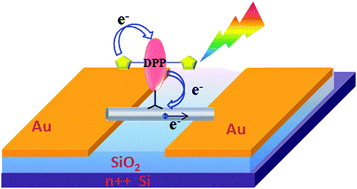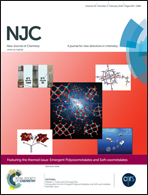Broadband photoresponse promoted by interfacial electron transfer in diketopyrrolopyrrole-based compound/ZnO hybrid nanocomposites†
Abstract
Photoinitiated interfacial electron transfer from organic semiconductors to inorganic ones is extremely important in organic/inorganic hybrid optoelectronic materials. Herein, we have prepared hybrid ZnO nanorods by grafting TDPP and TTDPP molecules through carboxyl acid groups. The steady-state spectroscopy results revealed that photoluminescence was subjected to severe quenching in the hybrid nanocomposites. Furthermore, time-resolved fluorescence and femtosecond transient absorption data verified the occurrence of the interface charge transfer between TDPP or TTDPP molecules and ZnO nanorods in the hybrid nanocomposites. The high performance UV-vis photodetector based on the TTDPP/ZnO hybrid have been fabricated with a photoresponsivity of 16.9 A W−1 and an on/off ratio as high as 104. The excellent visible-light photoresponse of the hybrid device can be attributed to the broadband absorption after the anchoring of the TTDPP compound on the surface of ZnO nanorods, the efficient cascade charge transfer process and the excellent capability of ZnO nanorods to provide direct and stable pathways for the transport of photogenerated electrons toward the collection electrode. This provides guidelines for the construction of organic/inorganic hybrids for optoelectronic applications.


 Please wait while we load your content...
Please wait while we load your content...